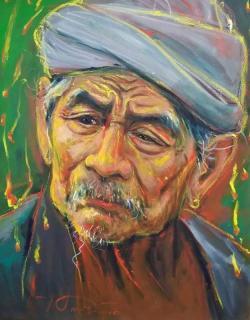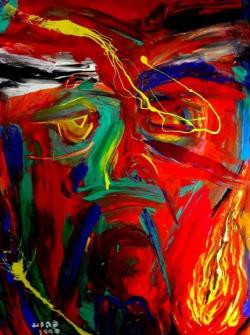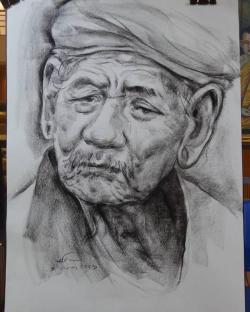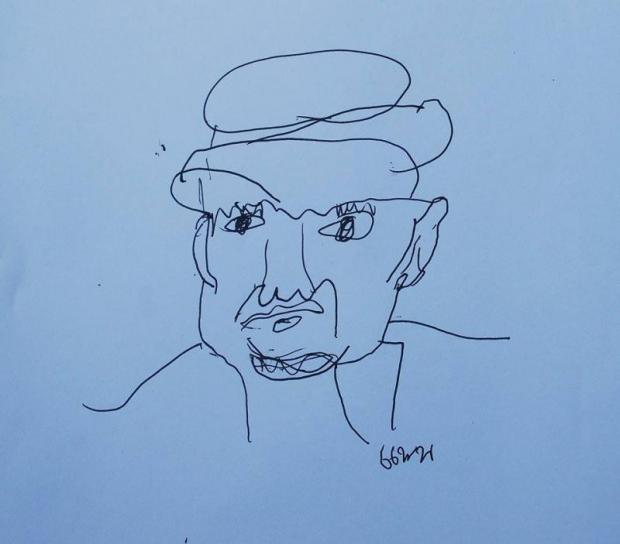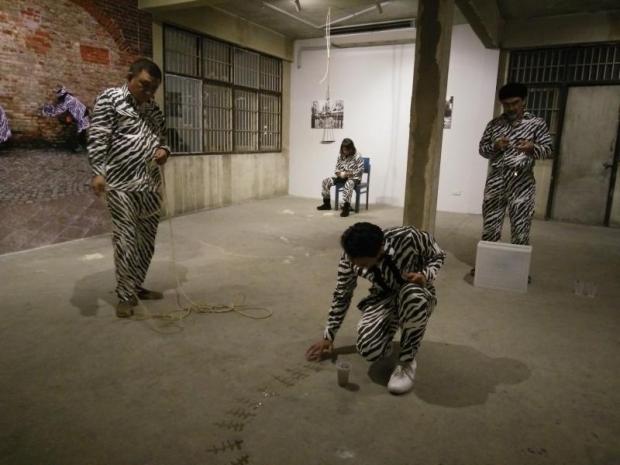
In the corner of a hall at the Bangkok Art and Culture Centre, performance artist and writer Jittima Pholsawek invites five audience members to join her for a meal during her evening show.
She spreads a piece of red fabric on a dining table. The audience members are seated at chairs and are presented with dishes of food and spoons.
The unexpected feast begins. Fried mackerel, green vegetables, purple potatoes, rice and spicy sauces are served.
"Feel free to have this nice food," Jittima says.
The diners feast like it's their last meal, choosing from the fresh food on the table.
One of them murmurs, "It tastes very good."
Jittima observes them with a faint smile. Then she removes something from her bag.
It's a long piece of fabric printed with military camouflage. She straightens it out and begins wrapping it around her head. Layer by layer, she covers her eyes, her mouth, and finally ties the fabric at the back of her neck.
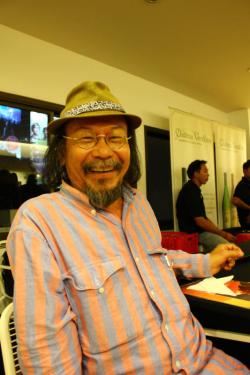
Portrait of an artist: Vasan Sitthiket, known for his politically charged art. Photo: Ezra Kyrill Erker
Her hands fumble for a dish. She grasps a portion of rice and tries to stuff it in her bound mouth. The food is stuck. She pushes again. She can't eat.
At this point, her fellow diners start feeling uneasy. But they continue filling their stomachs.
Ten minutes seem like an eternity and Jittima is still attempting the same act. She has managed to push some food into the opening of her covered mouth, but she cannot eat.
Eventually, she spits the rice out and removes the fabric. Her light smile returns. She can have some food.
The audience has different interpretations of her performance. One is that she's addressing violation of poor people's rights, losers under the military government's economic policy which has been criticised for favouring investors.
Jittima never explains what her message is. She is one of many emerging Thai artists who raise questions and convey dissent through different forms of art about life under a military regime.
Freedom of speech is being oppressed in many areas of political activism, especially ones that challenge the government's development policy and call for a return to democracy following the 2014 coup.
But art has not been silenced. While still risky, it represents a way of talking back to authority.
NOT JUST BLACK AND WHITE
On Sept 22, five performance artists -- Jittima, Chumpon Apisuk, Sompong Tawee, Pattree Chimnok and Satit Raksasri -- launched Zebra Project, dressing up in striped costumes and walking from the Bangkok Art and Culture Centre to Democracy Monument.
The performance addresses Thailand's chronic corruption by invoking zebra worship dolls, which are often seen at shrines and used as holy offerings to spirits in a gesture of thanks for granting prayers.
Not a native species to Thailand, zebras are used as a symbol of bribery, alluding to the national culture of paying police or government officers to get special services, regardless of whether or not it's fair.
Police visited the troupe at the start of their march to check the details of their performance. But they soon left, assuming that they wouldn't cause any trouble.
The artists ended their performance by taking photos at Democracy Monument, a hotspot for political gatherings. Black and white balloons were bobbing in their hands. The scene was peaceful.
Later, their photographs were shared on social media and displayed at Buffalo Bridge Gallery at Saphan Khwai.
The authorities' response to Zebra Project is different to that for other political protests focusing on corruption.
For example, when student activists boarded a train to Rajabhakti Park on Dec 7 they were intercepted and detained by the military for stirring political unrest and holding a gathering of over five people without permission.
The park in Prachuap Khiri Khan province was a billion-baht project built by the military that had been widely criticised for its lack of transparency over the commissioning of seven statues.
Art is less explicit in its criticism.
"Artists are rarely blocked [for criticising the government]," said Jittima. "Perhaps they might downplay the influence of artists to the public, or they may not understand our messages."
For decades, Jittima's work has exposed social, cultural and environmental issues in local communities, especially places where the government's proposed mega projects threaten local livelihoods.
Every government has participated in the violation of community rights, she said. But it has become more severe in recent years as individual opinions on controversial projects are silenced.
Some performances aim to criticise the execution of state development policy that's been put on hold.
This includes the gathering of potash mining protesters in Chaiyaphum in October last year in which local officers ordered protesters to remove their campaign shirts to avoid interrupting the government's reconciliation process.
They were threatened with being subjected to an order under Section 44 of the interim charter and told they could be sent for attitude adjustment.
In July, the family of an environmental activist in Chana district of Songkhla was reported to have been visited by local police several times in one week. They were warned to stop criticising the government's proposed coal-fired power plants in Thepha district.
Jittima describes the whole situation as "gloomy". She feels frustrated, and she channels this into art that raises questions about Thailand that seem to have been put on hold since the coup.
In her latest performances, she's used objects symbolising military power.
EVERYONE'S A CRITIC
Vasan Sitthiket is often recognised at the front line of political and environmental protest.
He is a bearded contemporary visual artist, a provocative poet, an anti-capitalist painter and opposed to Thaksin Shinawatra.
He appeared at political rallies for the People's Alliance for Democracy, active from 2006-2010, and the People's Democratic Reform Committee that led to the 2014 coup.
Despite being criticised for supporting the coup, he has challenged the military government of Prayut Chan-o-cha.
In early August, he appeared in front of Government House to read poetry that called upon the regime to suspend the controversial Pak Bara deep sea port project in Satun and end chronic corruption.
"If I'm put in detention, I'm prepared for that," he said.
Art may not sway policymakers, but it can make people think and act, he said.
Despite his frustration, Vasan's art has flourished and he has created many paintings that criticise the government.
Since the protests began in late 2013, the BACC has hosted exhibitions that express criticism of political deadlocks and, since May 2014, the coup.
One of those is Concept Context Contestation: Art and the Collective in Southeast Asia, which premiered at the BACC in December 2013. Now on display in Yogyakarta, Indonesia, it brings together artists' critical views on dominant social ideologies and political narratives.
The exhibition features Vasan's Blue October Series, which depicts the brutality of Oct 6, 1976, which led to a military coup.
In February, Thammasat University students received widespread praise for their political mockery during the traditional parade for the annual football match with Chulalongkorn at National Stadium.
The parade featured the popular Facebook social commentator "Ejeab Liabduan", known as a doomsayer who always roots for the side that turns out to lose later, holding a "We love Thai soldiers" sign.
Before the event, the National Council for Peace and Order said it wouldn't ban the parade. However, police appeared at the stadium to screen elements of the floats, seized a few posters with satirical statements and arrested student activist Sirawith "Ja New" Seritiwat on an outstanding warrant.
ON THE DECLINE?
"Artists have to be more careful in expressing political views," said Manit Sriwanichpoom, a photographer and owner of Kathmandu Photo Gallery. "But I may not be on their radar."
Self-censorship is a concern for him. Exhibitors may censor an artist's work if it's deemed to involve criticism of the government.
Manit considers the likely reaction to his political work before its debut. He makes sure that he can communicate his messages without being seen as an opponent of anyone. He still tries to act as an independent-minded individual as he sees the role of artists as very important now.
His recent show, Fear, consists of a photography series and video works, which address life under military rule and his concern for the future of Thailand due to its decades of political turmoil.
Exhibited in Bangkok and Singapore, it features a series of pictures called The Parliament of Happy Generals, pixelated images of faceless high-ranking military and police officers who are members of the National Legislative Assembly.
Beneath a bright yellow plane, a broad composite photo titled Queuing for Happiness shows Thai citizens lining up for free goods at the military-sponsored Reconciliation Festival, an initiative geared towards "restoring people's happiness".
He has questioned the political situation, such as the new constitution drafted under the junta's ruling, and if it truly seeks to return power to the people.
Bureaucratic power seems to have risen, as reflected in the proposed appointment of 250 senators in the draft constitution endorsed by the August referendum.
In previous cases of political turmoil such as the Oct 14, 1973 uprising and Oct 6, 1976 massacre, he sees the situation painted as a black-and-white affair, meaning there is a clear division of interests between the military and the people.
But the current political situation has divided people into many camps, such as pro- and anti-military, oppositional and neutral, which only aggravates the conflict. The military wins because of people's loss of unity, he said.
"Artists can't get away from this conflict either," Manit said. "They have different opinions and questions for each other. It's making the power of art decline. I'm not sure how art can have real influence under these circumstances."
Artists tend to be interrogated about what side of the political divide they belong to, instead of the specific issues that their pieces address.
GOT THE POWER
But the power of art is still evident in some issues related to the abuse of power.
Early last month, the Central Administration Court issued its verdict for a lawsuit filed by a group of ethnic Karen people in Kaeng Krachan National Park in Phetchaburi.
The group alleged park officials burned the Karen huts, rice barns and personal belongings, and forcibly moved them to a new resettlement in 2011.
They claimed their rights to live in the park territory due to their ancestors' history of settlement.
The court rejected their claims, saying that they had encroached on the forest, meaning the official had the right to launch the eviction operation.
A long-term forest dweller and one of the plaintiffs, Ko-ee Mimee, 105, muttered words that became widely shared on social media: "When I first opened my eyes, the forest was there. When I first drank my mother's milk, the forest was also there."
The verdict prompted artists to express their frustration.
A graphic designer, using the Facebook account "Shy Run", made a graphic of Mr Ko-ee that went viral on social media.
It shows a comparison of two edited pictures -- Mr Ko-ee in traditional Karen costume standing in front of a bamboo hut, and another of him in a grey suit with a luxury car and modern house.
The question "Which status will not result in him being evicted by fire?" appears across the work.
Other artists spoke up on their Facebook accounts.
The issue of ethnic people's rights suddenly came to light after years of Karen evictions that had gone largely unacknowledged by the public.
Following the verdict, Jittima started recruiting artists to show support for the Karen in Kaeng Krachan.
At first, she thought she would get a few participants. Her group initially planned to hold their artworks in front of the Central Administration Court to protest against the verdict.
But more than 100 pieces showing Mr Ko-ee's face flooded in from both professional and amateur artists.
Various methods were used, including paintings on canvas and rock, ink sketches and paper cutouts. Many participants were young artists, including children.
Their works will be exhibited at the BACC from Friday until Oct 16.
Jittima knows from experience art can challenge state power, as in Mr Ko-ee's case.
She believes art is like a hammer used to pound on people's minds to instil social awareness, even under the most constrained political circumstances.
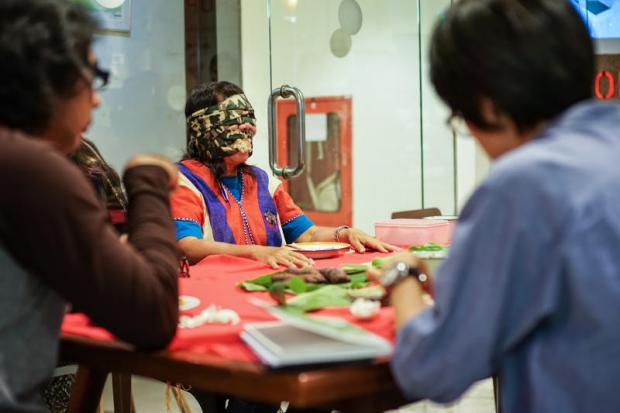
LET THEM EAT CAKE: Performance artist and writer Jittima Pholsawek evokes themes of corruption and consumption with a piece staged at the Bangkok Art and Culture Centre. Photo: Piyasak Ausap
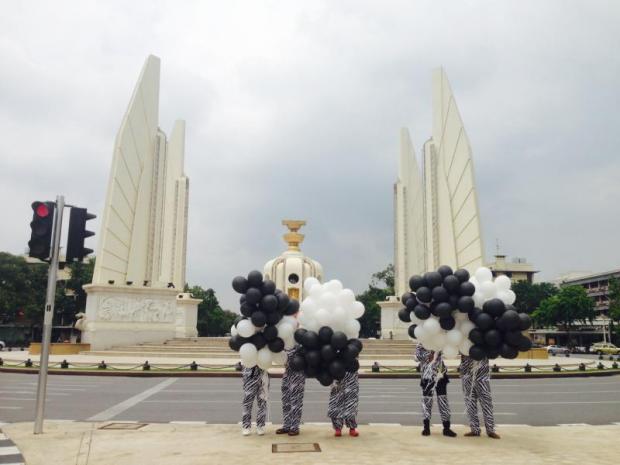
herd mentality: Jittima Pholsawek, Chumpon Apisuk, Sompong Tawee, Pattree Chimnok and Satit Raksasri at Democracy Monument in 'Zebra Project'. Photo: TransborderNews

DON'T RAIN ON MY PARADE: Little political satire was held back during the parade before February's Chula-Thammasat football match. Photo: SEKSAN ROJJANAMETAKUN
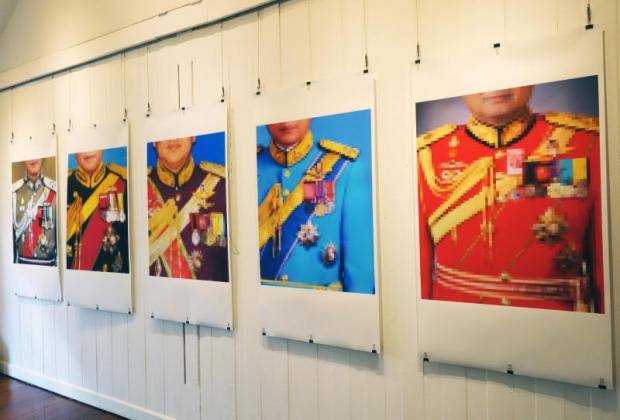
CALL TO ARMS: Manit Sriwanichpoom's 'Five Generals Who Return Happiness to Thailand', right. Photo: Manit Sriwanichapoom


